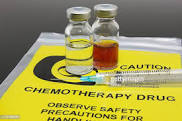
Diagnosed with Cancer? Your two greatest challenges are understanding cancer and understanding possible side effects from chemo and radiation. Knowledge is Power!
Learn about conventional, complementary, and integrative therapies.
Dealing with treatment side effects? Learn about evidence-based therapies to alleviate your symptoms.
Click the orange button to the right to learn more.
Oncology’s Maximum Tolerated Dose

In my experience as a cancer survivor, maximum tolerated dose (MTD) is often much too much toxicity for many newly diagnosed cancer patients.
Full disclosure- The majority of my experience both as a survivor as well as a researcher, is with a blood cancer called multiple myeloma. Because side effects are so prevalent with my cancer, I can’t help but be biased.
I’m not going to debate the reasons why conventional oncology steers the treatment of newly diagnosed cancer patients toward MTD.
I will, however, caution all newly diagnosed cancer patients about the tendency of conventional oncology to over-treat cancer patients due to MTD.
What are the problems associated with maximum tolerated dose in clinical trials?
The concept of Maximum Tolerated Dose (MTD) is primarily associated with early-phase clinical trials, particularly in the context of testing new drugs or treatments. While MTD has been a standard approach, there are several concerns and limitations associated with this concept. Some of the problems with the Maximum Tolerated Dose in clinical trials include:
- Overemphasis on toxicity: The primary focus of MTD studies is often on identifying the highest dose that can be administered without causing unacceptable toxicity. This emphasis may overlook other important aspects of treatment efficacy and may not reflect the optimal therapeutic dose.
- Limited information on efficacy: MTD studies may not provide sufficient information on the efficacy of a drug, as the main goal is to determine the maximum dose that can be tolerated without excessive toxicity. This may result in missed opportunities to identify effective doses that fall below the toxic threshold.
- Patient heterogeneity: Patients in clinical trials can vary significantly in terms of age, health status, and other factors. Determining a single MTD may not account for individual variability, leading to potential overexposure or underexposure in certain subgroups.
- Late identification of optimal dose: Identifying the MTD often occurs late in the drug development process, which may result in delays in determining the optimal therapeutic dose for further development. This delay can impact the overall timeline for bringing a drug to market.
- Ethical concerns: Administering doses that are expected to cause significant toxicity in order to determine the MTD raises ethical concerns. This approach may expose patients to unnecessary risks without a clear understanding of potential benefits.
- Dose escalation designs: Traditional dose-escalation designs used to find the MTD may not always be the most efficient or informative. Adaptive trial designs that consider accumulating safety and efficacy data during the trial could be more beneficial.
- Limited consideration of chronic toxicity: MTD studies may not adequately assess the potential for chronic toxicity, especially when evaluating drugs intended for long-term use. Toxic effects that manifest over an extended period may not be adequately captured in short-term studies.
- Influence on subsequent trial phases: Decisions made based on MTD studies can significantly impact the design and outcomes of later-phase clinical trials. If the MTD is not truly reflective of the optimal therapeutic dose, it may lead to suboptimal dosing in subsequent trials.
You’re a newly diagnosed cancer patient. How are you expected to figure out if your oncologist is giving you too much chemotherapy???
In my experience, the only way to do this is to take each NDC patient one at a time.
- How old are you,
- what are your symptoms,
- what are your goals,
- what has your experience been, etc.
You are going to have to talk with your oncologist about this. And you have to be aware that changes are good that your oncologist makes money based on how much chemo you do.
Are you a newly diagnosed cancer patient? What type of cancer? What symptoms are you experiencing? Have you been given a stage of cancer? If you’d like to learn more about how to manage your cancer, send me an email-
David.PeopleBeatingCancer@gmail.com
Hang in there,
David Emerson
- Cancer Survivor
- Cancer Coach
- Director PeopleBeatingCancer
Optimizing the doses of cancer drugs after usual dose finding
“Since the middle of the 20th century, oncology’s dose-finding paradigm has been oriented toward identifying a drug’s maximum tolerated dose, which is then carried forward into phase 2 and 3 trials and clinical practice.
For most modern precision medicines, however, maximum tolerated dose is far greater than the minimum dose needed to achieve maximal benefit, leading to unnecessary side effects.
Regulatory change may decrease maximum tolerated dose’s predominance by enforcing dose optimization of new drugs. Dozens of already approved cancer drugs require re-evaluation, however, introducing a new methodologic and ethical challenge in cancer clinical trials…
Since the 1950s, dose finding in oncology has been premised on three core assumptions.
- First is that a drug’s therapeutic window—the margin between its efficacy and toxicity—is necessarily narrow.
- Second is that the relationship between a drug’s dose and its efficacy is, within the constraints imposed by clinical toxicity, very steep and positive.
- Finally is that, because there is a perceived dearth of potentially efficacious drugs, false-negative early phase trials are a bigger problem than false-positive early phase trials.
Taken together, these assumptions biased oncology’s usual dose-finding efforts toward identifying the highest dose possible—“more is better.”
Shortcomings of this approach are manifold:
- It biases toward overdosing,
- neglects the biological target of interest, and
- hardwires toxicity into cancer treatment, irrespective of a candidate drug’s selectivity.1
For those reasons alone, the usual dose-finding paradigm would merit reconsideration. More critically, however, the three core assumptions listed above are untenable in the precision medicine age,2 and even if we truly did want to know a drug’s maximum tolerated dose (MTD), current designs often fail to estimate it accurately.3,4…
Conclusion
Challenging the high-dose paradigm for cancer drugs
“Chemotherapies aim to destroy as many cancer cells as possible, so drug development is guided by a preference for high doses. The standard approach to clinical trials for cancer drugs is to increase the dose until one-third of the participants abandon the trial. Drug-makers typically select a dose just below this as the default level to enrol more participants.
This ‘maximum tolerated dose’ approach is now being challenged in the United States. Officials at the Oncology Center of Excellence (OCE), part of the US Food and Drug Administration (FDA), are becoming concerned that the side effects of some cancer drugs are so toxic that patients stop taking them, writing in a 2021 New England Journal of Medicine editorial1 that sometimes “less is more”…


